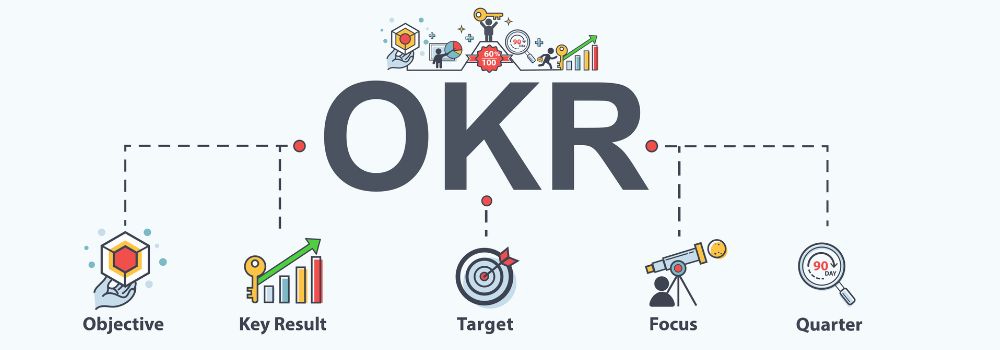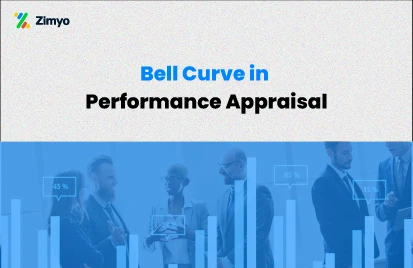At first glance, OKRs and KPIs may appear to be an alphabet soup, yet they are effective tools for creating and achieving goals. In performance management meetings, comparing OKR vs KPI is a popular topic, yet it’s an apples-to-oranges comparison. Although there may be some overlap, these concepts are fundamentally unique.
You must have a well-thought-out plan and a distinct framework for defining goals and monitoring performance if you are serious about fulfilling your business goals, fostering growth, and getting results. Two examples of the various ways you can manage and track the performance of your company strategy are KPIs and OKRs.
What should you use out of these, and why? OKRs or KPIs? And do they genuinely complement one another or do they each play a part in how your strategy is carried out?
In this article, we’ll take a look at both, when each should be used and which one can be the best bet for your company goals.
What is a KPI?

The term “KPI” stands for “Key Performance Indicator.” In business, the KPI is common ground to give numerical targets for achieving a specific goal.
These quantifiable figures show how well your company is doing in terms of achieving objectives like targeted monthly client growth or targeted revenue growth. KPIs help organizations, divisions, teams, and people in establishing clear goals and tracking their development in relation to those goals.
The majority of businesses use KPIs to track the monthly growth of key business measures and revenue goals. KPIs allow you to monitor all of your routine business activity. Depending on what you want to monitor, these goals can be annual, quarterly, monthly, daily, or even hourly.
KPI is used to evaluate past performance and better anticipate future outcomes. For example, which months or regions will generate sales, how many deals will one sales executive close, and what is the expected average transaction value?
KPI Examples
In every industry, there are countless examples of KPIs. Any quantitative metric that a business employs to assess its performance and successfully accomplish its objectives can be considered a KPI. It’s crucial to remember that your KPIs can and should be divided down by department unless you have a very small business.
Here are a few common KPI examples for various sectors and divisions:
- HR: attrition rate, employee performance, average recruitment time, etc.
- Sales & Marketing: customer lifetime value, sales revenue, calls made, etc.
- Technology & IT Consulting: monthly recurring revenue, customer retention or churn, ticket resolution time, etc.
- Healthcare: patient wait time, average treatment charge, number of educational programs, etc.
What is an OKR?

The term “OKR” stands for “objective and key results,” and more specifically, “key results are linked to objectives.” KPIs are metrics that are included within a framework, whereas OKR is a strategic framework.
OKR is a simple, binary strategy that employs particular metrics to monitor objective achievement. A company typically has three to five high-level objectives with three to five critical outcomes for each of those objectives. To provide a clear performance evaluation for the goal, key results are quantitatively evaluated. The OKRs are:
- Always measurable
- Able to receive an objective score between 0-1 or 0-100
- Time-bound
- Ambitious
The OKR framework was made popular by Google and Intel, but it is also used for goal management by Amazon, LinkedIn, Spotify, and other phenomenally successful businesses. In general, firms that place a strong emphasis on growth should employ OKRs instead of KPIs.
OKR Examples
OKRs should straddle the “nearly impossible” line since they are based on overarching objectives that are intended to drive employees and organizations forward. The cycle of rapid, dynamic growth inside the OKR framework never ends.
Here are a few common OKR examples:
Objective: To dominate the market for our industry.
Key Result #1: Generate 100 million in revenue.
Key Result #2: Increase employee hiring by 45 percent.
Key Result #3: Raise market cap to enter Fortune 500.
Objective: Increase revenue by 30 percent.
Key Result #1: Bring in 50 new clients.
Key Result #2: Generate 20% more marketing leads.
Key Result #3: Increase customer retention to 85%
OKRs vs KPIs: What’s the Difference?
Using OKRs, you can determine exactly what aspects of your business need to be improved and, based on that, how you will allocate your time and resources over the next three months. It’s just as important to turn down opportunities as it is to seize them.
While OKR is a goal-setting technique that helps you enhance performance and drive change, KPIs are business metrics that measure performance. KPIs inform you of the data you must evaluate in order to establish the foundation for your OKRs.
Both OKRs and KPIs are quantifiable and evaluate the performance of the team. When comparing OKRs and KPIs, what differs is what you measure specifically and how you determine those metrics.
KPIs are used to assess performance, however, they are unable to reveal what must change or improve in order to boost those figures. They are high-level company performance measurements that you monitor frequently and precisely (yearly, quarterly, monthly, weekly, etc.).
OKRs are used to determine what needs to be changed, corrected, or improved. After determining which area needs improvement, you establish an objective specific to that area and key results to gauge your progress toward this objective. Therefore, Key Results are particular to a target area that is represented by an objective.

| KPI | OKR |
|---|---|
| Business metric that reflects performance | Goal setting method that improves performance and helps identify areas of improvement. |
| Leadership led- Top down | Bottom up and Top down |
| For measuring & managing performance | For alignment, engagement and focus |
| Not changeable on a regular basis. | Frequently set, adaptive, tracked, and re-evaluated |
| Measures the level of performance you want to achieve. | Highlights a specific area of improvement to focus on |
| Monitors the steady state and provides benchmarks. | Informs everyone on what is important to achieve company goals. |
KPI & OKR Best Practices
KPIs – How to Design KPIs?
When it comes to KPIs:
Keep your KPIs as low as possible: Only some information is absolutely crucial. We advise choosing one to two KPIs for each objective—metrics that will actually allow you to assess your progress.
Make sure KPIs are both ambitious and reachable: Your team members need a challenging goal that motivates them to work harder, but a goal that is too far out of their reach will simply make them frustrated.
Be precise: By attaching each KPI to a goal and comparing it to a target, you can give value to each KPI.
KPIs should be regularly reviewed and updated: Re-evaluating your performance measures is a wonderful idea during strategy meetings. If a KPI doesn’t seem to be a reliable indicator of success or if the associated goal has changed, you might need to make adjustments or do away with it entirely.
We also recommend that you don’t:
Track each and every performance metric used by your company in one place: Only track and report on the metrics that are most important and valuable to your business at the executive level. For department-level objectives, you can develop additional KPI dashboards and reports.
Track KPIs using spreadsheets: Spreadsheet monitoring will only make the process more difficult to manage unless you’re just experimenting with KPIs for the first time or on a temporary basis.

OKRs – How to Build OKRs?
When it comes to OKRs, we recommend you:
Begin with a few clear goals to make it easier to adopt OKRs. As you gain expertise and buy-in, you can add levels for departments (and even specific people) after you’ve established enterprise-level OKRs as a starting point.
Consider the present. OKR cycles are repeated every month or every three months. Therefore, as you’re developing them, consider the objectives you may accomplish within this period that will significantly benefit your business.
Ensure that executives are on board with your OKRs. OKRs effectively map out the strategy your business will use to achieve its objectives. Your leadership team won’t be following in your footsteps if they aren’t committed, which will inevitably result in failure.
We also recommend you don’t:
Create OKRs without knowledge of what other business units are doing. OKRs ought to be developed bottom-up. Establish your OKRs at the organizational level first, then roll them down to the departmental, team, and perhaps even individual levels.
Use the OKR model if your firm is focused on growing slowly. For rapid growth, OKRs are preferable. If you consistently track the same element each quarter, you will lose momentum with OKRs.
OKR vs. KPI: Which is Better?
The secret is that you need both OKR and KPI for any firm to be successful.
If you were solely keeping an eye on KPIs, you wouldn’t know how close you were to your goal. You should be able to set realistic goals to achieve more ambitious outcomes. Your teams should be responsible for achieving the goal, and there should be motivation and enthusiasm to do so.
KPIs and OKRs really complement each other fairly well. With OKRs defining a focal area and quantifiable objectives to be reached to deliver on those improvements, on the flip side, KPIs serve as a starting point for discussions about changes to implement or issues to solve.
In today’s AI-driven era, companies all over the globe, no matter big or small, are using tools like OKR Software and other automated solutions to make professional life easier. These solutions increase the overall productivity and efficiency of employees.
You can figure out how to manage your business by comparing your performance to KPI targets. Simply put, if you are not tracking your KPIs, your business will not be functioning or well-organized.
Having these numbers, however, doesn’t provide you with specific suggestions on how to improve them. Simply stating, “We need to meet a larger revenue target,” won’t help a business grow. What specifically do you need to change to get back on track if you’re missing your KPI targets? Here is when OKRs can be useful.
The Bottom Line
As you can see, the “OKRs vs. KPIs” notion contains two frameworks with utterly different purposes and underlying assumptions. KPIs and OKRs, all function well together, and both frameworks should be used in your company, but for very different things. Use KPIs to track overall business performance and OKRs to define objectives and enhance your company.
Using OKRs for improvement-oriented and targeted goal-setting is absolutely essential. The OKR methodology has many advantages for organizations, including alignment of objectives, company-wide transparency, and clear communication of goals.






